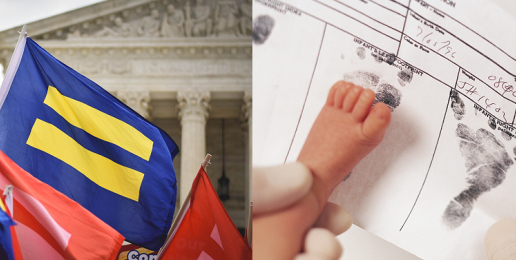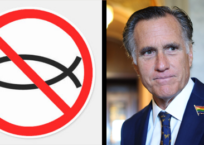
In June of 2015, the U.S. Supreme Court ruled in Obergefell v. Hodges that same-sex couples could not be denied marriage licenses by states. However, on December 8, 2016, the Arkansas Supreme Court correctly ruled that the Obergefell decision should not be used to re-write all state laws relating to family, parenthood, and vital records, when they are unrelated to the issuance of marriage licenses.
The decision, in the case of Smith v. Pavan, overturned a lower court decision that had declared the Arkansas law governing birth registration unconstitutional. The statute in question says that in the absence of a court order or agreement by all parents and spouses involved,
“If the mother was married at the time of either conception or birth or between conception and birth the name of the husband shall be entered on the certificate as the father of the child.”
The law had been challenged by three lesbian couples. In all three cases, one of the women had borne a child who was conceived through artificial insemination involving an anonymous sperm donor as the father. When the children were born, the couples sought to have the names of both women listed on the birth certificate as the child’s parents. The Arkansas Department of Health (ADH) refused.
The legal principle involved has long been known as the “presumption of paternity.” If a married woman gives birth to a child, her husband is presumed to be the father of that child. Something which is factually true in the vast majority of cases is simply presumed to be true under the law.
Advocates of same-sex marriage and homosexual parenting, however, seek to convert the “presumption of paternity” into a gender-neutral “presumption of parentage.” Under this view, the legal spouse—regardless of sex—of a woman who gives birth is presumed to be the child’s other parent.
In other words, they would have the law go from presuming something that is almost always factually true to presuming something that cannot possibly be factually true—namely, that two women are both the biological mother of a newborn child.
Fortunately, the Arkansas Supreme Court rejected the absurd outcome of presuming the impossible.
In a model of judicial restraint, they interpreted the words of the statute by “giving the words their ordinary and usually accepted meaning in common language.” Noting that the dictionary definition of “husband” is “a married man,” and of “father” is “a man who has begotten a child,” they concluded that “the statute centers on the relationship of the biological mother and the biological father to the child, not on the marital relationship of husband and wife.”
The court’s opinion cited an affidavit by the ADH’s Vital Records State Registrar elaborating on the rationale for this approach:
The overarching purpose of the vital records system is to ensure that vital records, including birth certificates as well as death certificates and marriage certificates, are accurate regarding the vital events that they reflect…
Identification of biological parents through birth records is critical to ADH’s identification of public health trends, and it can be critical to an individual’s identification of personal health issues and genetic conditions.
To emphasize the significance of—and differences between—biological motherhood and biological fatherhood, the Arkansas Supreme Court also cited language from a 2001 U.S. Supreme Court decision involving a question of citizenship for children born out of wedlock and outside the United States to one American parent. Ruling (in Nguyen v. INS) that Congress could treat children of American fathers differently from children of American mothers, the Court said,
[t]o fail to acknowledge even our most basic biological differences—such as the fact that a mother must be present at birth but the father need not be—risks making the guarantee of equal protection superficial, and so disserving it. Mechanistic classification of all our differences as stereotypes would operate to obscure those misconceptions and prejudices that are real… The difference between men and women in relation to the birth process is a real one, and the principle of equal protection does not forbid [legislative recognition of that fact].
Ironically, the author of the decision in Nguyen was Justice Anthony Kennedy—who also wrote the Obergefell decision on marriage.
LGBT activists, of course, will deplore the Arkansas decision. Perhaps, in the wake of Donald Trump’s election to the presidency, they and other liberals will even be tempted to lump it together with what they stereotype as other acts of “bigotry” committed by “angry white males.” Yet the Arkansas Supreme Court has a female majority—four women and three men. Three of the four women joined the majority opinion in the birth certificate case, while two of the three men dissented. And the opinion of the court was written by Associate Justice Josephine Linker Hart—a female pioneer in the legal profession in Arkansas, an Army veteran, and a woman with Cherokee ancestry.
The truth is that every child has both a mother and a father—even if the latter is only an anonymous sperm donor. The truth is that two women (or two men) alone can never conceive a new human life. The truth is that a birth certificate or registration is supposed to record the factual circumstances of a biological event—the birth of a child.
When the Obergefell decision was handed down, those celebrating it used a simple slogan: “Love Wins.” (The fallacy in that was the assumption that any and every relationship characterized by “love” is constitutionally entitled to be designated a “marriage.”)
Pro-family Americans can be grateful that, at least in the Arkansas Supreme Court, “Truth Wins.”
This article was originally posted at the FRC blog.































